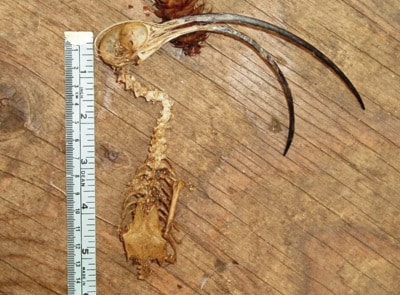By Sherry Lidstone
Several years ago an unusual bird turned up at one of my feeders. It was a male Northern Flicker (red-shafted) with a very odd looking bill, at least twice the normal length and with a noticeable downward curve. I first noticed him mid winter, on the ground, among dozens of other birds, pecking at sunflower seeds. I was quite excited to say the least and decided to keep an eye on him to see how he faired; thus began a 760 day relationship between myself and this unfortunate soul.
Over the course of time, the flicker’s bill grew longer and the lower mandible began to curve awkwardly to the left. This was one determined bird though as he devised new ways in which to secure food.
The cobs of dried corn that had been put out for the squirrels were one of his favourite feeders. He would rake his upper mandible back and forth and up and down the cob loosening the kernels until they dropped to the ground. The flicker would then fly to where the tidbits had fallen, turn his head sideways and scoop up a kernel in a chopstick like manner. Once the kernel was secured in his bill, he would lift his wing, place his bill under it and slide his bill in and out until the kernel reached his tongue.
He used similar actions on the suet feeders, raking his upper mandible in and out of the suet cage until it was coated in suet which he would then lick off. He was particularly adept at feeding on ants as well. He would stand beside a mound, poke his upper mandible in the center and the ants obligingly climbed up his bill and in to his waiting mouth.
When drinking from the birdbath, he would tilt his head completely sideways in order to get a sip. Never once, in all the 760 days did the flicker ever make a sound and each time he flew in, the other birds gave him a wide berth.
As time passed, both mandibles grew longer and became weak and floppy, hampering its ability to successfully ingest food. The last time I saw him, he tried, unsuccessfully, to feed from the suet cage but he could no longer control his bill. He flew off and I never saw him again. I worried about his fate for months, always searching for him, even asking neighbours to keep an eye out for his remains.
Two years passed and I had all but given up finding the flicker. In early Spring 2006, a gale force wind roared through McLure and blew down an old, dead poplar tree in our front yard. Being as the tree had dozens of previously used nest cavities, my husband was very careful not to cut through any while bucking the tree up. Our plan was to put the cut sections around the yard hoping the birds would use them when they arrived for nesting season.
While cutting one area that would have been at six feet above ground had the tree still been standing, feathers started to fly out of one of the cavities. He stopped cutting and called for me to come have a closer look. I could hardly contain my excitement as I knew what I was about to find, my flicker! There he was, face down inside the cavity.
Had my husband cut an inch higher we would have never found him and an inch lower, the bird would have been destroyed by the chainsaw. The flicker’s remains were nothing more than a skeleton and his neck had a severe “s” shape leading to the assumption he had flown in to the cavity as a normal flicker would but had become wedged while trying to turn around.
After searching for the flicker for two years, it was a humbling experience to know he was only fifty feet from where I had last sighted him. I walked past that tree dozens of times and had no idea he was in there. The flicker never once uttered a sound while he was alive and so its life seemed a silent struggle and it was obvious its death was as well.
I’ve only seen one more bird with a deformed beak, a year or so after the flicker first appeared. It was a female black-chinned hummingbird. The tips of her beak were spread apart at the ends much like a cocktail wiener fork. She had no problem fitting her beak in the feeder port holes though. Her fate remains unknown.
Over the past several years, Alaskan’s have witnessed a startling increase of beak deformities among local birds. Large numbers of black-capped chickadees and smaller numbers of many other species of birds have appeared with grossly overgrown and crossed beaks.
In addition to the huge number of observations in Alaska (the highest concentration of such abnormalities ever recorded in a wild bird population anywhere!), there have been increasing numbers of reports from the Yukon Territory, British Columbia, and Washington State.
If you happen to see any birds with bill deformities, please report them to the link below. This is the only agency I know of that is studying this phenomenon and has a wealth of information and an astounding amount of photos of birds with deformed bills.
http://alaska.usgs.gov/science/biology/landbirds/beak_deformity/observerreport.html
Or mail your photos and information to: USGS Alaska Science Center, 4210 University Dr., Anchorage, AK 99508.
This malady is becoming more prevalent and so far the cause is unknown. But it’s pretty scary though to think we humans are mostly likely the reason for these deformities.
Until next time, Happy Birding!
